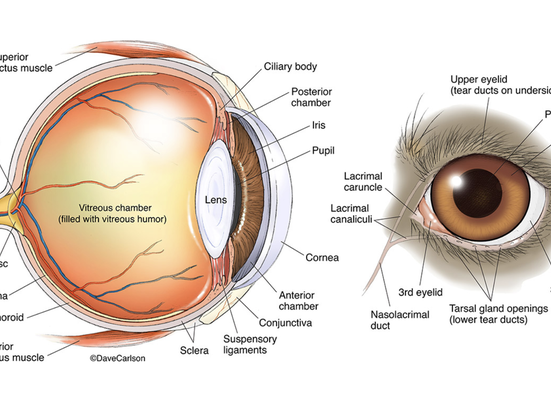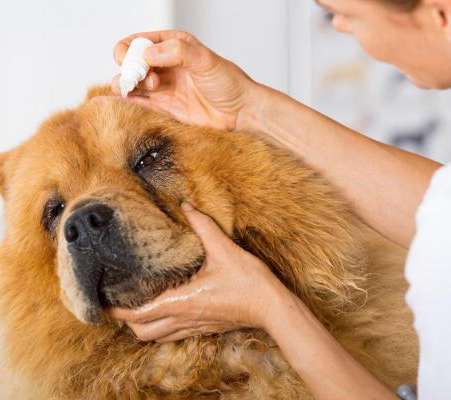A healthy dog’s eyes should be clear, bright and free from dirt, discharge and inflammation.
Eye Care
Common Symptoms of Illness
- Red inner eyelids
- Matter ‘stuck’ on the surface or in the corners of the eye
- Cloudiness within the eyeball
- A dull eye surface
- The ‘third eyelid’ coming across the eye
- Excessive tearing or unusual discharges
- Tear-stained fur around the eyes
Eye Tests used to Diagnose Eye Problems
- Fluorescein stain to identify the presence of corneal ulcers
- Schirmer Tear Test to determine the level of tear production
- Ocular pressure to detect glaucoma
- Ophthalmoscope to see in the eye chamber

How to Administer Eye Drops
You may need to muzzle your dog.
2. Remove any discharge around the eye with a cotton ball moistened with warm water.
3. See the instructions on the bottle for dosage. Shake if necessary.
4. Use one hand to hold the bottle between thumb and index and place the other under your dog’s jaw to support the head.
5. Tilt the head back and, to prevent blinking, use your free fingers to hold the eyelids open.
6. Hold the bottle close to the eye but DON’T touch the eye’s surface.
7. Squeeze the drops onto the eye and once the drops are in, release the head.
8. Your dog will blink, spreading the medication over the eye’s surface.

How to Apply Eye Ointment
1. You may need to muzzle your dog.
2. Remove any discharge around the eye with a cotton ball moistened with warm water.
3. Check the instructions on the tube for dosage.
4. Gently pull back upper and lower eyelids.
5. Holding the tube at a 45° angle to the lower eyelid, squeeze the ointment on to its edge. DON’T let the tube touch the eye’s surface.
6. Lightly massage upper and lower eyelids together to spread the medication.
7. Release the head. Let your dog blink.
-
IMPORTANT: Always administer medicine to its full term for it to be effective. When administering medication stay calm – your pet can sense if you are nervous making it more difficult to apply the treatment. Always praise and reward your pet with a treat.

Common Eye Conditions & Symptoms
Conjunctivitis is an inflammation of the membrane that covers both the inner lining of the eyelid and the white of the eye. It may be caused by infections, allergies, inadequate tear production or irritation.
Keratoconjunctivitis Sicca (DRY EYE) occurs when the tear glands cannot provide a dog’s eyes with enough tears. The most common cause is destruction of the lacrimal gland by cells of the immune system, but viral diseases, drug reactions, allergies or injuries can also lead to this condition which, if chronic, can cause loss of vision. Certain breeds are predisposed.
Corneal Ulceration can result when the cornea’s surface is scratched by a foreign object or is damaged by inadequate tear production or bacterial infection. Very painful, it causes dogs to ‘squint’. Breeds with bulbous eyes and ageing dogs seem to be prone to this problem.
Epiphora If your dog’s eye constantly ‘weeps’, or if the fur around it appears ‘stained’, the normal tear flow may be blocked.
Cataracts & Glaucoma Dogs, just like humans, can have these serious eye diseases. Cataracts, which cloud the lens inside the eye, are commonly seen in elderly and diabetic dogs and are the most common cause of canine blindness. A hereditary condition in some breeds, early examination by your veterinarian is important, as such animals should not be bred. Glaucoma stems from too much pressure being exerted upon the eye’s interior as a result of a decrease in the amount of fluid draining from i
